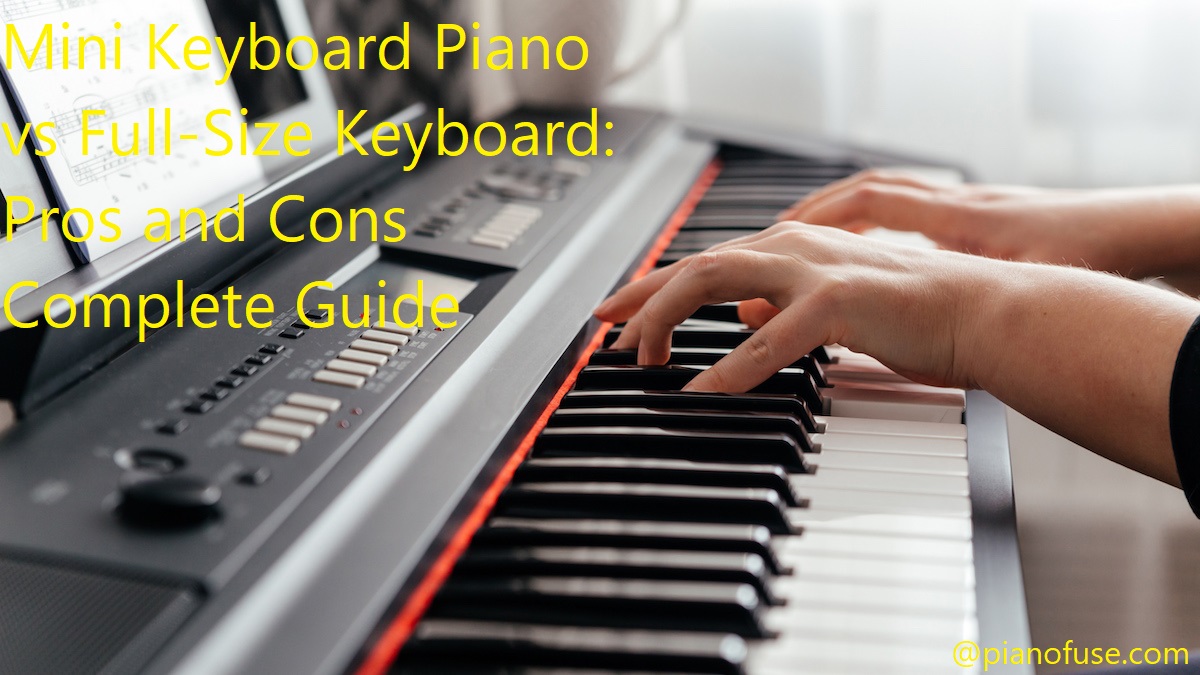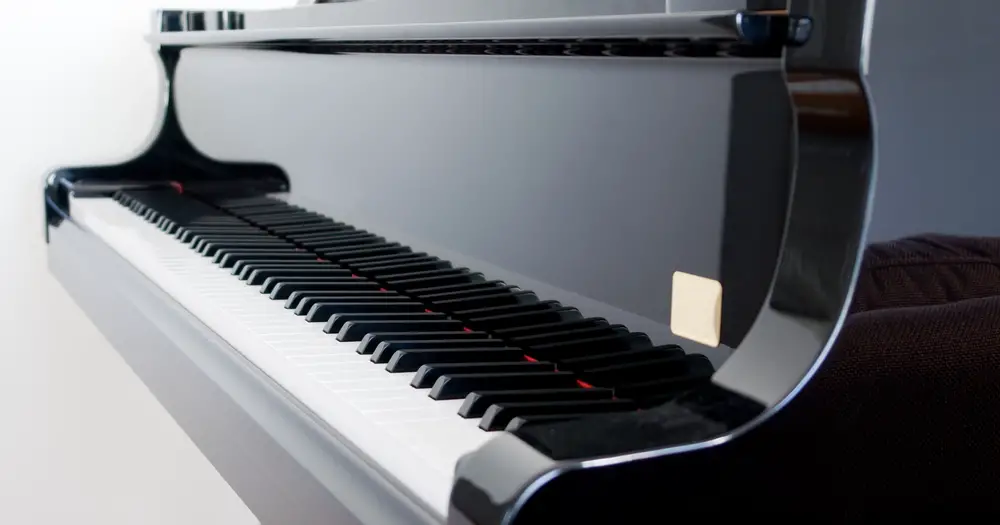Do you want to learn how to play the piano? Are you looking for the best way to make your musical journey more enjoyable and hassle-free?
In this guide, you’ll discover the advantages and disadvantages between a mini keyboard piano vs full-size keyboard. Whether it’s for leisure or professional use, find out which is best suited for you.
When it comes to choosing the perfect keyboard for your individual needs, there are different factors to consider. This guide will help you decide between a mini keyboard piano and a full-size keyboard. We’ll go into details about each type of keyboard, discuss the pros and cons of each option, and provide tips on how to choose the best one for you.
Mini Keyboard Piano: As their name suggests, mini keyboards are smaller than regular-sized keyboards and come in a number of sizes and configurations. They are typically much more portable than full-sized instruments and have fewer keys (usually around 25). They also tend to have fewer options than larger keyboards when it comes to features such as drum noises or sustain settings.
Full-Size Keyboard: Full-size keyboards generally range from 61 up to 88 keys depending on the model chosen. Additionally, they usually offer more features such as multi-track recording capabilities or drum setting options. These pieces of equipment usually require a lot more space than smaller ones do and may require an amplifier if you want to play louder volumes due to their increased size.
Explanation of the topic
Pianos come in all shapes and sizes, including mini keyboards and full-size keyboards. It can be difficult to decide which is the right one for you, so it’s important to understand the advantages and disadvantages of each type of piano before you make your decision.
Mini keyboards are typically much smaller than traditional full-size keyboard pianos and have fewer keys, usually ranging between 25 to 61 keys. Due to their small size, they are lighter and more portable than their full-size counterparts, making them ideal for people who need a space-saving instrument or for those looking for an easily transportable option. Mini keyboards also tend to be more affordable than their full-size counterparts, making them a great choice for beginner pianists or those on a budget.
However, mini keyboards lack some of the features that make learning and playing on traditional keyboards so effective — namely size and range. Most mini keytar models are limited to two octaves or less due to the shorter key length found on these instruments. This limits the types of music one can play since most songs require longer notes that span multiple octaves. Additionally many mini keyboard models lack true weighted keys that provide resistance against finger pressure just like on real acoustic pianos, further limiting tactile feel when playing.
Full-Size Keyboards are much larger than Mini Keyboards with 88 keys spanning 7 octaves as well a range of other features such as sustain pedals for added expression when playing complex pieces. Full sized keyboards simulate “real” pianos which aids in learning how to use finger pressure effectively during performace due to weighted action keys used on these type of piano models. Furthermore many higher end musical digital piano styles feature realistic 88 key hammer action keys plus velocity sensing capabilities providing further fluidity in performance unmatched by most lower end models with unweighted keys. Despite the weight they can still be easily moved around while at home thanks to included wheels/cranksets making them highly portable despite their large size. Of course this comes at a higher cost as these type of instruments are typically several times more expensive then basic Mini Keyboards.
In conclusion, both Mini and Full size Keyboards offer pros and cons based off user preferences depending upon user needs such as portability, affordability or even tactile feedback nuances when performing complex pieces. As such exploring available options carefully can help understand what best fits your needs before purchasing an instrument that meets desired needs.

Close up hands of caucasian woman playing synthesizer
Mini Keyboard Piano
Mini keyboard pianos are a great option for those looking to take their music skills to the next level. They offer an attractive, portable size and weight while still featuring many of the same notes and functions of a full-size keyboard piano. The smaller size means you can bring your musical joy along wherever you go, from school, to practice, to even gigs or shows. Mini keyboards often have added functions like drum pads and additional sounds that increase their versatility and make them more fun to play with.
Despite the smaller size, mini keyboards often come with a full 88-key range of notes just like their larger counterparts. Mini keyboards also tend to be significantly more affordable than regular pianos, so they’re ideal if you’re on a tight budget or want something specifically for practicing at home or in a small space.
However, there are some drawbacks associated with mini keyboard pianos that should be taken into consideration before committing to one as your primary instrument. They may not provide as realistic of an experience as larger instruments due to being unable to accurately simulate the feel and weight of actual piano keys. Additionally, due to the size limitation some mini keyboards can have limited presets and sound options when compared with full-size models.
Definition and features
A keyboard instrument is any musical instrument which is played using a musical keyboard. Keyboards are found on a variety of electronic instruments, including synthesizers, digital pianos, organs and even some drum machines. A full-size keyboard contains 88 keys and is the most commonly used type of keyboard instrument, while mini keyboards often contain less than 60 keys. Both types of keyboards can be used to produce a wide range of musical sounds, but they have many differences that may impact their suitability for your particular setting or music style.
When choosing between a mini keyboard piano and a full-size keyboard, it’s important to consider the differences in features between the two. A full-size keyboard will typically have more features than smaller keyboards such as velocity sensitive keys, aftertouch capability and semi-weighted or weighted keys. These features will provide greater control over the sound produced by your instrument and may also help increase its longevity over time. Full size keyboards will generally have larger repertoires too with more expression capabilities such as sound layering abilities as well as virtual analog technology for richer sounds overall. In addition to these technical capabilities, full size keyboards tend to offer more integration options with compatible DAWs or other computers programs or applications making them easier to work with in a wide variety of settings.
On the other hand, mini keyboards may be preferred for certain purposes because of their smaller size and portability – they can often be kept in an overhead compartment while traveling on an airplane – as well as their lower price tag compared to larger instruments. Mini keybeds are also typically less nuanced than full size ones – though this isn’t necessarily true when comparing models within each category – but may still provide enough dynamic range for many casual players’ purposes. Furthermore, many modern mini keybeds may include important additional features such as wavetable synthesis or arpeggiators which add convenience during sound scripting sessions without sacrificing overall budget constraints; this makes them particularly attractive to those looking for a more ‘instant gratification’ approach to songwriting sessions – rather than having complex layers of synthesizers independently set up via knob tweaking – while still building compositions quickly and efficiently.
Pros
The debate over the size of digital keyboards has been ongoing for some time, with many pros and cons to consider. While the full-size keyboard offers the feel and versatility that an acoustic instrument can provide, mini keyboards could be a great option if you’re in search of a more compact, portable instrument.
Mini keyboards are typically designed with portability in mind. And since they come in an array of sizes with various features included, there’s something out there to suit everyone’s needs. They generally have more features than full-size keyboards due to their small size and are easy to transport—perfect for those looking for an on-the-go solution or just something convenient for taking lessons at home from time to time. Additionally, some have additional features such as built-in speakers and recording capabilities that can open up a lot of possibilities when it comes to performance.
Lastly, their smaller sizes also mean that mini keyboards tend to be more affordable than full-size models. If your budget doesn’t allow for a higher end instrument yet you still want that classic piano feel and sound then these are definitely worth considering before going all out on a larger model.
Portability
Portability is an important factor to consider when choosing between a mini keyboard piano and a full-size keyboard. Mini keyboards, sometimes referred to as portable keyboards, are often much smaller and lighter than their full-size counterparts. A mini keyboard can easily fit in any space – even on top of a small table in a living room, or tucked away into the corner of a bedroom – without taking up too much room or weighing down the area. This makes them great for those who travel frequently, or who want the flexibility to bring their instrument along with them wherever they go.
In contrast, full-size keyboards tend to be much larger and heavier than mini keyboards. While this size allows for greater range and larger keys that are easier to press down, it also means that transporting your instrument can be difficult and inconvenient. If you plan on moving your instrument around frequently or traveling with it extensively, you may want to opt for something lighter (like a mini keyboard). On the other hand, if you anticipate setting up and leaving your instrument in one place most of the time anyway (e.g., in an office or music room), then having more features/keys may outweigh portability considerations. The choice ultimately comes down to personal preference and lifestyle needs!
Cost-effectiveness
One of the most significant pros to consider when purchasing a musical instrument is cost-effectiveness. When it comes to mini keyboard piano versus full-size keyboard, both have some advantages in this regard.
Mini keyboards tend to cost considerably less than their full-size counterparts, making them an ideal choice for those on a budget. In addition, they are designed to be more compact, meaning they take up less space and can be stored more easily. Furthermore, mini keyboards generally come with fewer features than larger models and are usually made with simpler technology, resulting in a friendlier price tag and fewer maintenance costs overall.
On the other hand, full-size keyboards provide more flexibility as many offer a wide range of powerful features such as digital sound production capabilities and built-in effects processors. They also offer extended octaves which provide greater range of notes for sophisticated arrangements. Moreover, larger keyboards often come with weighted keys that simulate the feel of an acoustic piano or organ when played – an appealing feature for professional musicians looking for authenticity in sound and playability.
Ideal for beginners and children
Mini keyboard pianos are an ideal choice for beginners and children because they offer many of the features of a full-size keyboard at a fraction of the cost.
Mini piano keyboards are small in size, typically a few octaves shorter than a full-sized one. This can be both an advantage and a disadvantage depending on your needs. On one hand, they contain fewer keys, making them easier to play as you can reach all the notes quickly with your hands. At the same time, you may miss out on some of the nuances that can make playing classical pieces more enjoyable or difficult.
Mini keyboards are usually more affordable than their full-sized counterparts and have fewer bells and whistles. They may offer fewer sound options or accompaniment tracks that offer more complex rhythm patterns than miniature pianos. They also will not have standard features such as weighted keys or midi output found on most professional grade regular sized pianos.
For this reason, it is important to consider your own skill level when deciding between larger and mini keyboards in order to find an instrument that is suitable for your application yet does not limit your growth potential as an artist.

Cons
Full-size keyboards are large instruments and may not be suitable for people with space constraints. Also, due to their size, they may be difficult to transport and store. Lastly, they tend to be more expensive than mini keyboards since they include more features like more keys, better built-in speakers, a variety of tones and voices etc.
Another disadvantage of full-size keyboards is that the keys can become slick or worn out if used over time. Also, some users may find the size of the keys uncomfortable or too small for comfortable playing. Furthermore, these heavier keyboards will require an additional cost for stands and cases which could push the cost up even further for those who do not already have them at home.
Finally, in comparison to mini keyboards which are powered by batteries or just through USB connection option, full-size keyboards often require a power outlet in order to function properly. This means that you will need to research your area first in order to find an outlet that is conveniently located so you can always plug it in and practice without any inconveniences.
Limited range of keys
One major downside of mini keyboards is the limited range of keys available. Often this is limited to 25 or 32 keys. Depending on the size and type of music you are playing, fewer than 88 keys can be a big issue. For complex and larger pieces, having fewer octaves can make it difficult to play certain passages easily and accurately. Furthermore, it can limit your ability to work in certain musical styles that require a full range of notes.
This isn’t an issue if you are just starting out and haven’t yet developed a need for a full range of notes and sounds, but as you progress in your studies and knowledge you may find yourself wanting more than what a mini keyboard offers. In this case, it may be worth investing in a full-size keyboard so you have access to all the notes and effects that come with playing on more than just 25 or 32 keys.
Lack of features
One of the most prominent disadvantages associated with a mini keyboard piano is the lack of features compared to a full-size keyboard. Mini keyboards are often limited in their range and number of keys; they typically have as few as 25 keys compared to the 88 you would find on a full-size keyboard. As such, mini keyboards may not be able to produce some of the more sophisticated tones and sounds that you can get with a full-size keyboard.
As well, many mini piano keyboards have fewer (or no) programmable functions or ability to modify existing sound effects or samples. The lack of knobs, faders and buttons may also limit your ability to create new sounds or customize existing ones with a mini piano. The size and weight also will affect how much control you can have over these effects.
If you want more intricate effects than what is included in your mini keyboard’s features you may need an additional device for further tweaking. Likewise, if having MIDI ports for connecting to other instruments is important to you then a mini piano won’t suffice – full-sized keyboards offer more options for connecting to various sound sources and external hardware.
Difficulty playing complex pieces
When it comes to playing complex pieces, large keyboards are considered to be more suitable. This is largely due to their larger range of keys; while a mini keyboard piano may feature 61 or 76 keys (or fewer depending on the model), full-size keyboards are available in 88-key models providing you with two extra octaves of sound which can be instrumental in mastering those more intricate compositions.
Since mini keyboard pianos have fewer keys, it will be more difficult for experienced players to learn and recreate challenging pieces because of the necessary transposing certain passages require. On the other hand, if you’re just starting out and are new to piano, you may find that mini keyboards offer a great way to introduce yourself to playing without investing a lot of money into an expensive full-size keyboard you may not even need yet.

Conclusion
In conclusion, whether a mini keyboard piano or a full-size keyboard is the best option for you will depend on individual factors and circumstances. Generally, mini keyboards are best for those looking for an affordable and space-saving instrument, whereas full-size keyboards can provide a more complete musical experience.
If you are still unsure of which type of keyboard to buy, it may be helpful to consider your available budget as well as the intended use (i.e., practice/learning// performance). Ultimately, the right choice is the one that works best for your individual circumstances; after all, having a great instrument goes a long way towards helping you become an excellent musician!
FAQ’S
Is it OK to learn piano on a small keyboard?
Yes, it is possible to learn piano on a small keyboard, but it may be more challenging to transition to a full-size piano later on. It’s important to choose a keyboard with weighted keys and a minimum of 61 keys.
Should I get a full size piano keyboard?
If possible, it is recommended to get a full-size piano keyboard with 88 keys, as this will allow you to play a wider range of music and develop proper technique.
What is the difference between small piano and big piano?
The main difference between a small piano and a big piano is the size and number of keys. Small pianos typically have fewer than 88 keys and are designed for smaller spaces, while larger pianos have a full 88 keys and are intended for larger performance spaces.
Do I need a mini keyboard?
It is not necessary to have a mini keyboard, but it can be a convenient option for those with limited space or who need a portable instrument. However, it’s important to choose a mini keyboard with weighted keys and a minimum of 61 keys.
Are small hands a disadvantage for playing piano?
Small hands can be a disadvantage for playing certain pieces of music, but it is still possible to learn and play piano with smaller hands. It’s important to choose an instrument with a lighter touch and to focus on developing proper technique.
Are small keyboards better for typing?
Small keyboards may be more convenient for typing on the go, but they may not be as comfortable for extended typing sessions as a full-size keyboard with a traditional layout.
Can you learn piano on a mini piano?
Yes, it is possible to learn piano on a mini keyboard, but it may be more challenging to transition to a full-size piano later on. It’s important to choose a keyboard with weighted keys and a minimum of 61 keys.
Should a beginner buy a piano or keyboard?
For most beginners, a keyboard is a more practical and affordable option than a full-size piano. However, it’s important to choose a keyboard with weighted keys and a minimum of 61 keys.
What keyboard to buy for beginners?
Some good options for beginner keyboards include the Yamaha P-45, Casio Privia PX-160, and Korg B2. It’s important to choose a keyboard with weighted keys and a minimum of 61 keys.
What is a good keyboard for beginner piano lessons?
A good keyboard for beginner piano lessons should have weighted keys, a minimum of 61 keys, and a range of built-in sounds and features to keep students engaged. Some good options include the Yamaha P-45, Casio Privia PX-160, and Korg B2
See Also:
- Best piano mic 2023
- Best portable digital piano 2023
- Best portable piano keyboards 2023
- Best upright piano 2023
- Best yamaha digital piano 2023


